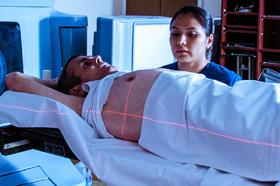
October 31, 2012 — Concurrent use of sorafenib and stereotactic body radiotherapy (SBRT) for advanced liver cancer patients resulted in high toxicity and is not recommended outside of clinical trials, according to research presented at the American Society for Radiation Oncology’s (ASTRO’s) 54th Annual Meeting. This is the first prospective study of SBRT combined with sorafenib for hepatocellular carcinoma (HCC) patients, and initial outcomes indicate that the dose of sorafenib and the volume of tissue irradiated are key factors in the risk of toxicity; alternative sequencing of therapies should be investigated in future studies.
This phase I trial was designed to test the safety of the combination of SBRT and sorafenib in advanced HCC patients. Sorafenib is a targeted therapy that reduces cancer cell proliferation and cancer blood vessel formation; it is the standard of care for patients with locally advanced HCC. In this study, SBRT was delivered after one week of sorafenib, and sorafenib was continued during and after SBRT in 16 patients. Four patients in the study had a low burden of HCC, requiring less than 40 percent of their liver to be irradiated (low effective liver volume irradiated, Veff), and 12 had a larger burden of HCC, requiring 40 to 60 percent of their liver to be irradiated (high Veff). Twelve patients were classified as stage C on the Barcelona Clinic Liver Cancer (BCLC) rating system and exhibited symptomatic tumors, vascular invasion or extrahepatic spread. Ten of 16 patients in the study exhibited tumor invasion involving major vessels. The study found that the toxicity of sorafenib, even at lower than standard doses and sometimes before SBRT was started, was higher than expected. The study authors recommend sequential SBRT followed by sorafenib for future studies, rather than a concurrent approach.
For the low liver Veff group, 400 mg of sorafenib daily (half of standard dose) appeared tolerable, with no dose without toxicity, although one patient was taken off therapy due to low platelets (grade 3 thrombocytopenia). Due to the toxicity levels reported in the high liver Veff group and low accrual, patients in this group were not advanced to the next higher dose of sorafenib. For the high liver Veff group, 200 mg of sorafenib daily was the maximum dose tolerable; 400 mg of sorafenib daily resulted in luminal gastrointestinal (GI) toxicity in two patients approximately three months after SBRT treatment. Two patients were removed from the study prior to SBRT due to liver enzyme increase and tumor rupture after seven and three days of sorafenib, respectively. One of six patients in the high Veff group, who was treated with 200 mg of sorafenib daily, developed tumor rupture five weeks after SRBT. Another patient developed grade 3 liver enzymes after seven days of sorafenib and was removed from the study. Despite these toxicities, the overall radiologic response rate was 40 percent, far higher than expected following sorafenib alone. The median survival has not been reached, and follow-up is ongoing.
Patients who participated in the study had locally advanced HCC not suitable for standard local or regional therapies. They had intact liver function and were classified as having Child-Pugh score ‘A’. The Child-Pugh scoring assesses the severity of liver disease and a patient’s estimated survival rate based on the liver function, according to the degree of ascites (fluid build-up in the abdomen), the plasma concentrations of bilirubin and albumin, the prothrombin time and the degree of encephalopathy (confusion). The dose escalation plan for sorafenib began with 400 mg (200 mg by mouth twice daily) and was planned to be increased in 200 mg increments to reach a maximum dosage of 800 mg (400 mg by mouth twice daily, standard dose). Patients received study dose sorafenib one week prior to, two weeks during and four weeks post SBRT with continuation of standard dose sorafenib where possible. Dose-limiting toxicity was defined as grade 3, 4 or 5 related toxicity occurring within three months following SBRT. SBRT doses ranged from 39 to 54 Gy in six fractions over two weeks, and the maximum permitted dose to hollow GI organs (e.g. stomach, large or small bowel) was 31 to 34 Gy.
“Patients with advanced hepatocellular carcinoma are most often not suitable for potentially curable treatments such as surgery, liver transplant or radiofrequency ablation. Some of these patients are candidates for treatment with sorafenib, the present standard of care, which delays progression modestly but does not cure,” said Laura A. Dawson, M.D., lead author of the study and a radiation oncologist at Princess Margaret Hospital in Toronto. “SBRT is a promising therapy for patients with locally advanced liver cancer, and our prior studies demonstrated that the majority of patients treated had control of their irradiated tumor at one year following treatment. Our present study investigated the combination of SBRT and sorafenib in patients with advanced liver cancer. We found that even though low levels of sorafenib combined with SBRT were tolerated by patients requiring a low volume of normal tissues to be irradiated, serious toxicity was seen more commonly than expected with the combination. In order to minimize the risk of toxicity, concurrent use of sorafenib and SBRT is not recommended for patients with advanced liver cancer. Sequential treatment with SBRT and sorafenib is preferred, and the volume irradiated should be kept as low as possible. On a positive note, the majority of irradiated tumors were controlled following SBRT.”
The abstract, “Phase I Study of Sorafenib and SBRT for Advanced Hepatocellular Carcinoma,” will was presented in detail during a scientific session at ASTRO’s 54th Annual Meeting on Oct. 28, 2012.
For more information: www.astro.org


 December 11, 2025
December 11, 2025 









